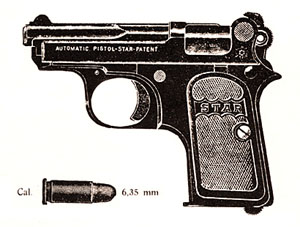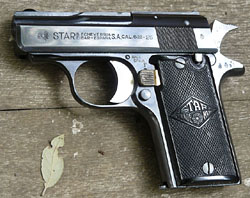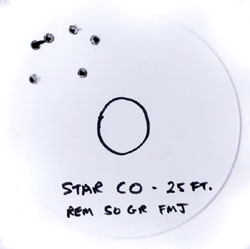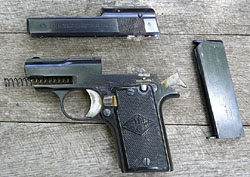 |
|||||||||||||||||||||||||||||||||||||||||||||||||||||||||||
|
The Star Model CO by Ed Buffaloe
Early Star 6.35mm Pistols Bonifacio and his father José Cruz started a small workshop in Eibar in 1905 in the hope of manufacturing a pistol which had been designed by Julian, based on his experience with the La Lira. Julian’s pistol reflected the influence of the Steyr-Mannlicher--it was blowback operated, with a fixed barrel, an open-top slide, and a top-mounted extractor. The external look of the gun, with its scalloped breech block and round checkered gripping surfaces, was also strongly reminiscent of the Mannlicher. The exposed barrel portion, forward of the breech, was uniquely styled, with a rib on top that ran the length of the barrel. The gun, which has become known as the Star Model 1906, bore the legend “AUTOMATIC PISTOL-STAR-PATENT”, but did not have the star logo with streaming rays. Antaris states that “Julian’s plans for a pocket pistol in 6.35mm (.25ACP) were completed by 1905...” But I find it hard to believe that Julian was designing a gun for the 6.35mm cartridge as early as 1905. Although FN patented Browning’s 6.35mm pistol in 1905, the gun and the cartridge did not reach the market until mid-1906, which is why it is typically known as the FN Browning Model 1906. There is a photograph in Antaris’ book of an early prototype of the Star 1906 pistol which he says is dated 24 December 1906. I suspect that in 1905 Julian was still designing for the 5mm Clement Auto, or possibly some other small auto cartridge, and I would hazard a guess that the Echeverrías may have prototyped Julian’s pistol in 6.35mm by late 1906, but it is unlikely that any commercial production actually took place that year. The 1906 pistols are so scarce that it is possible they may have only served as prototypes for the Model 1908. If commercial production of the 1906 did take place, it was exceedingly limited. Ezell’s Handguns of the World, and Hogg & Weeks’ Pistols of the World do not mention the Star Model 1906 at all and show the earliest Star pistol as the Model 1908. The Models 1906 and 1908 are both shown in A.B. Zhuk’s Illustrated Encyclopedia of Handguns, but they are misidentified. Julian Echeverría’s Model 1906 received Spanish patent number 40,763 on 21 June 1907. While based on the Mannlicher design, it does not have the wrap-around cover for the lockwork and recoil spring, but instead has removeable sideplates held on by screws.
Late in 1908 the Echeverrías introduced another design by Julian, which was simply known as the Star Number 2 or N-2 pistol. This gun bore some resemblance to the 1906 FN Browning, but had a fixed barrel, a removeable breech block, a manual safety lever mounted on the tang behind the left grip, and a magazine that held 7 rounds. Within a year it was redesigned, with a slightly longer barrel and shorter grip, and a fixed breech block in the slide. This second variation held only 6 rounds in the magazine. The third variation was in 7.65mm only. The N-2 guns were only manufactured for four years. José Cruz died in 1909, and for a short time Julian joined his older brother Bonifacio to form the company that was known briefly as Bonifacio y Julian Echeverría. But in 1910 Julian left to pursue other interests. In 1913 Julian helped Esperanza y Unceta set up their factory to produce the Campo-Giro pistol, and later that year accepted a position as director of the Escuela de Armeria (Armory School) of Eibar which was the first vocational school in Spain. Julian remained with the Armory School until 1938. The company he had formed with his brother was subsequently known as STAR-Bonifacio Echeverria. The Star Model 1914 was primarily manufactured in 7.65mm, though apparently a very limited number were made in 6.35mm. This gun more closely resembled the Steyr-Mannlicher (and the La Lira) than Star’s earlier pistols, even to the lever in front of the trigger guard that allowed removal of the recoil spring and guide, after which the slide could be removed. Being essentially intended for military use, it had a U-shaped lanyard on the lower rear corner of the left grip. Star is estimated to have sold about 20,000 of the 7.65mm version to the French during World War I, where they were more popular than any other Spanish pistol due to their very high quality of manufacture. The Star Model 1919 was an updated 1914, and was made in 6.35mm, 7.65mm, and 9mm short. The most obvious differences between the M1914 and M1919 were that the M1919 had a smaller magazine release button, a more exaggerated hammer spur, and a lanyard that swiveled. But there were many other changes. According to Antaris, the slide was longer and the frame heavier, the serrations on the forward portion of the frame were finer, the extractor was redesigned, and the hammer turned on a pin rather than a screw. The two larger calibers came in two frame sizes and three barrel lengths. The 6.35mm version had hard rubber grips with the Star banner, and was referred to as the Pocket Model. The larger guns had checkered walnut grips and were referred to as the Military Model. The very early 6.35mm Model 1919 pistols had a rowel hammer. The Star Model 1926 was an update of the M1919 that was available in 6.35mm and 7.65mm. The old safety that blocked the firing pin was eliminated in favor of a lever on the left side of the gun that ran under the grip and locked the sear in place. The top-mounted extractor was shortened, the firing pin was retained by a pin rather than by the bolt that the safety turned on as in the M1919, and the magazine release was smooth rather than checkered. The M1926 was also available in two frame sizes and two barrel lengths. The diminutive 6.35mm was known as the Vest Pocket Model, the 8-shot 7.65mm was known as the Pocket Model, and the 9-shot 7.65mm was known as the Military Model. A few rare Target Models were also assembled with an extra long barrel, adjustable sights, and a target trigger In 1926 the 6.35mm Model E appeared, said to have been inspired by the Walther Model 9. But in reality the Walther and the Star were both based on the earlier Mannlicher design, and the Star Model E was clearly an evolution from previous Star 6.35mm pistols which had had fixed barrels, open-top slides, and top-mounted extractors. The Star Model E was definitely closer in appearance and size to the Walther than previous Stars, featuring a manual safety lever (like the one on the M1926) and a button for removing the slide at the rear of the frame on the left side. Unlike the Walther Model 9, however, and more like the Colt 1911, the Model E also had a magazine release button behind the trigger, an external hammer, and a lengthened grip tang to protect the shooter’s hand from the recoiling slide. It held six rounds, and was the smallest gun ever made by Star (like the Walther, it was only 100mm long). During the first year of production, Model E pistols had two takedown buttons, one on each side, but the right side button was quickly eliminated as being unnecessary. The prototype Model E had a sight safety similar to that of the Colt Automatic Pistol of 1900. Antaris states that the Star Model CO was produced from 1929 through 1956, after which it was replaced with the Model CU. (Gangarosa states that the Model CO appeared in 1941 and was produced until 1957, and Hogg and Walter state that it was made from 1930 to 1937.) The Model CO was based on the Model E, but the barrel returned to the styling of the earlier Star 6.35mm pistols, which went all the way back to the Model 1906. The size also reverted to that of the earlier Star 6.35mm pistols. The CO pistol holds eight rounds in the magazine. The overall design of the CO (fixed barrel, open slide, external hammer, etc.) remains the same as the earliest Star pistols. The takedown was identical to that of the M1926. The CO was replaced by the Model CU. The traditional styling of the exposed barrel was eliminated, and the safety was moved from behind the trigger to behind the left grip, giving the gun an even closer resemblance to the 1911 Colt. An aluminum frame model was later introduced as the CK. In the U.S. the CK (and possibly the CO) became known as the Starlet.
The gun I own appears to have been shot very little, and the tolerances are so close that I sometimes have minor difficulties in disassembling it. It shoots a little high and to the left at 25 feet (with 50 grain Remington FMJ cartridges), but it groups reasonably well for such a short barrel. Chambering is smooth and ejection is positive. The only problem I found is that it would occasionally not cock the hammer under recoil. I believe this was because the gun was not fully broken in, because after I put about 150 rounds through it the problem went away. Field Stripping:
|
|||||||||||||||||||||||||||||||||||||||||||||||||||||||||||
|
Copyright 2008 by Ed Buffaloe. All rights reserved. |
|||||||||||||||||||||||||||||||||||||||||||||||||||||||||||
|
|||||||||||||||||||||||||||||||||||||||||||||||||||||||||||
|
|
|||||||||||||||||||||||||||||||||||||||||||||||||||||||||||
 José Cruz Echeverría (1833-1909) learned gunsmithing while working for the Orbea Hermanos company of Eibar in the mid-19th century. By
1880 he had started his first business manufacturing muzzle loading guns. His son Bonifacio (1859-1951) studied metallurgy in Madrid and
later returned to Eibar to learn gunsmithing. Father and son both worked for a time at the Quintana Hermanos factory, making revolvers. Bonifacio’s younger brother Julian (1875-1948)
studied business in Bilbao and eventually became a firearms designer. Sometime around 1905 he worked for Gárate, Anitua y Cia and helped design their La Lira pistol, which was a copy of the
José Cruz Echeverría (1833-1909) learned gunsmithing while working for the Orbea Hermanos company of Eibar in the mid-19th century. By
1880 he had started his first business manufacturing muzzle loading guns. His son Bonifacio (1859-1951) studied metallurgy in Madrid and
later returned to Eibar to learn gunsmithing. Father and son both worked for a time at the Quintana Hermanos factory, making revolvers. Bonifacio’s younger brother Julian (1875-1948)
studied business in Bilbao and eventually became a firearms designer. Sometime around 1905 he worked for Gárate, Anitua y Cia and helped design their La Lira pistol, which was a copy of the 

 My Star CO is well made and has a highly polished deep blue
finish. It is quite heavy compared to other vest pocket pistols such as the Walther Model 9 and the Baby Browning, but the weight feels good in the hand and the extended grip gives the
shooter a firm purchase. This pistol will withstand the hottest loads available, such as the Magsafe 25D +P Defender ammo, which delivers 1670 feet-per-second and 127 foot-pounds of
energy from a short barrel, giving the diminutive .25 ACP round the same punch as a .32.
My Star CO is well made and has a highly polished deep blue
finish. It is quite heavy compared to other vest pocket pistols such as the Walther Model 9 and the Baby Browning, but the weight feels good in the hand and the extended grip gives the
shooter a firm purchase. This pistol will withstand the hottest loads available, such as the Magsafe 25D +P Defender ammo, which delivers 1670 feet-per-second and 127 foot-pounds of
energy from a short barrel, giving the diminutive .25 ACP round the same punch as a .32.